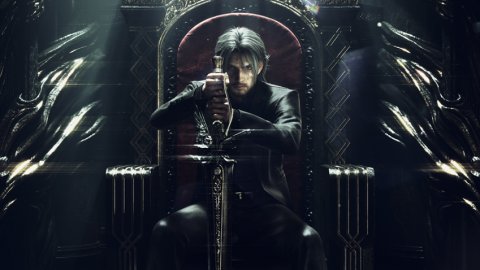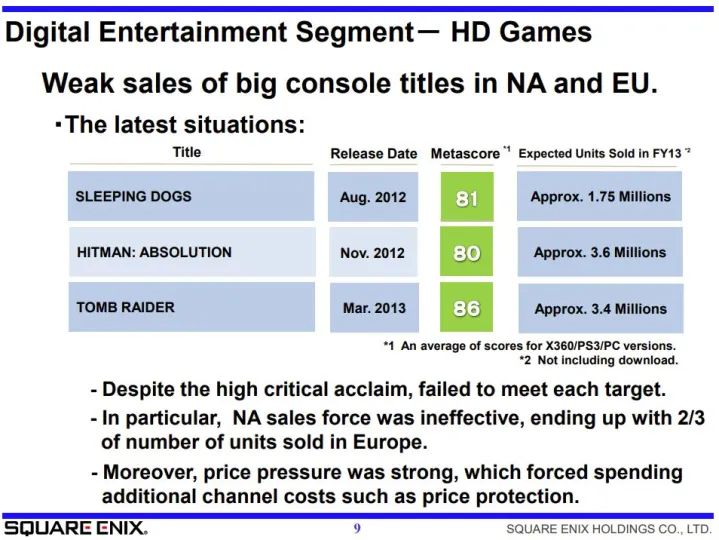
Final Fantasy 15 was initially in development at Eidos Montreal
In a recent interview published by True Achievement, a former art director of Eidos Montreal revealed that the team was initially tasked with starting the development of Final Fantasy 15 from Square Enix, before the work then moved on to the Japanese division's internal studio."We tried to work on Final Fantasy 15," explained Jonathan Jacque-Belletête, former art director of the Deus Ex team, "then they decided to move development to Japan - which I still believe was a mistake, but it's true. Our project was really, really beautiful ".
The question has not been further investigated and there is no way to understand how far development has continued within Eidos Montreal or if something of the work carried out by the western team was recovered, used or transferred directly to the build then developed by the internal team of Square Enix in Japan.
It is certain that Final Fantasy 15 has gone through an extremely complex genesis, with various changes of style, ideas and contents, therefore it is not excluded that something concerning the first versions of the game, also with regard to the materials disseminated to the public, had to do with the work of Eidos Montreal.
Jacque-Belletête's statement could also confirm an old rumor that emerged in 2018 from the Youtube channel SuperBunnyHop, which had revealed that Eidos Montreal had "some artistic elements and game design projects in a super secret office", on a project that was supposed to be a kind of "space opera RPG" with a love triangle and other elements that could be related to Final Fantasy 15, in fact .
If nothing else, this demonstrates how the use of Square Enix's western teams has always been quite eclectic and surprising, perhaps too much, so much so that we can hope for a clear change of direction now that Eidos Montreal, Crystal Dynamics and Square Enix Montreal were sold to Embracer Group. We also recently learned that Final Fantasy 15 has hit 10 million copies sold.
Source Did you notice any errors?
Square Enix’s studio sale is good news for everyone
If you’ve been following Square Enix closely over its life span, you’ve probably noticed that the publisher is impossible to pin down. Once renowned as the premier RPG studio thanks to franchises like Dragon Quest and Final Fantasy, the gaming giant has ballooned in size over the past decade. The company purchased several studios and began expanding its reach to Western audiences, moving beyond the RPG genre.
In 2022, that rapid growth was starting to feel unsustainable and it appears that Square Enix agreed. On Monday, the publisher announced that it was selling three of its biggest internal studios: Eidos, Crystal Dynamics, and Square Enix Montreal. Embracer Group will pick up all three studios for $300 million (a paltry number next to Microsoft’s $69 billion Activision Blizzard purchase), giving the company access to beloved franchises like Tomb Raider and Dues Ex.
It’s yet another chapter in gaming’s current acquisition craze, but one that feels more necessary than other recent examples of corporate consolidation. Square Enix is selling its way out of an identity crisis that was only hurting the studios under its banner. It’s hypothetically good news for everyone involved, though Square Enix is already in danger of making the same mistakes.
How we got hereThe rise of Square Enix as gaming’s most eclectic publisher is a story 20 years in the making. It began in 2003 when Square and Enix joined forces in a landmark merger. It was a match made in RPG heaven, creating a new Japanese megapower that held the keys to Final Fantasy, Kingdom Hearts, the Chrono series, Dragon Quest, and more.
If you focus too much on the global aspect, you might lose sight of who you’re actually making the game for.
But Square Enix wasn’t content with just being the king of one genre. Over the next decade, the publisher would rapidly expand, picking up companies like Space Invaders publisher Taiko and creating new studios to expand into new markets. The most significant turn happened in 2009 when Square Enix bought Eidos Interactive, the publisher behind Tomb Raider and Hitman, and its subsidiaries. Eidos played a crucial role in Square Enix’s growth. It was folded into Square Enix Europe, a subdivision that would focus on growing the publisher’s Western audience.
The move didn’t quite go as planned. By 2013, Square Enix was struggling to make a name for itself in the West. In an earnings report at the time, the company noted that Western titles were routinely failing to hit sales targets. Neither Tomb Raider or Hitman: Absolution moved over 4 million units at that point. Meanwhile, Square Enix continued to find success in Asian markets and was expanding into territories like Korea. After an “extraordinary loss” of 10 billion yen, the company restructured its management team for the first time since its merger.

In a 2014 interview with Nikkei Trendy, Square Enix President Yosuke Matsuda reflected on the company’s struggle. He noted that the surprise success of Bravely Default, a traditional JRPG, in the West had prompted a philosophical rethink at the company. “If you focus too much on the global aspect, you might lose sight of who you’re actually making the game for,” Matsuda said at the time.
While the acquisition news is initially shocking, it makes sense in context; the writing has been on the wall for Square Enix Europe since then. As high-profile games like Marvel’s Avengers flopped, it was becoming clear that Square Enix might be trying too hard to appeal to Westerners. The first sign that it was ready to cut that arm off the octopus came in 2017 when it decided to stop publishing games by Io Interactive, allowing the independent studio to take the Hitman series with it. By selling off its three major Western studios, Square Enix has finished a job a decade in the making.
What happens nextThe news is a net positive for everyone, in theory. For the studios that were sold to Embracer Group, it’s a potential blessing. Square Enix wasn’t doing them any favors, as Western games were becoming less of a priority. Talented studios like Crystal Dynamics have a better chance of avoiding mismanagement under a group like Embracer, so long as it’s committed to giving the studios its attention. It could also mean that dormant IPs like the Legacy of Kain could make a return, which opens up some exciting possibilities for fans.

For Square Enix, it means the company can finally focus. That’s something it desperately needs to do, especially after a string of high-profile failures like Babylon’s Fall and Balan Wonderworld. The publisher’s unruly release schedule should be more manageable when it doesn’t have to balance marketing massive Marvel projects with the kind of surefire hits that it knows it can knock out of the park with its core audience globally.
On paper, it’s a win-win situation. The question is whether or not Square Enix can actually settle down, and there’s good reason to believe history could repeat itself. As part of the sale news, the company announced that it will use the $300 million it’s gaining to move forward in its investments in “blockchain, AI, and the cloud.” That could be a potential red flag for the next decade for the company.
Of all those investments, cloud tech is the one that makes the most sense. Square Enix has long been a successful player in the mobile space, and it has experimented with cloud tech as part of that move. It’s also brought several of its games to Nintendo Switch as cloud versions recently, so it’s not surprising to hear that its looking to bolster its foothold with the tech, bringing its games to as many platforms and players as possible.

Blockchain presents a major question mark, though. Square Enix has shown great interest in the experimental tech as of late, but mainstream gaming companies have yet to find success with it. Just look at Ubisoft, which is currently struggling to implement its NFT service Quartz (it shuttered support for Ghost Recon Breakpoint altogether months after adding NFTs to the game). There’s a chance Square Enix is able to make a breakthrough with the tech, but not without facing a hostile reaction from its valuable fan base — the very players who kept the company afloat when its Western expansion wasn’t working.
Is Square Enix just going to pump money into another doomed business arm that doesn’t make a return on investment? And if it does, is it really any better off than it is now? Square Enix finds itself at a crucial crossroads. If it plays its cards right, it could bolster its position as a gaming giant by focusing on consistency. But if its poorly supported gambles continue to fail, the publisher could find itself looking for more bidders to snatch up the rest of the company soon enough.
Editors' Recommendations